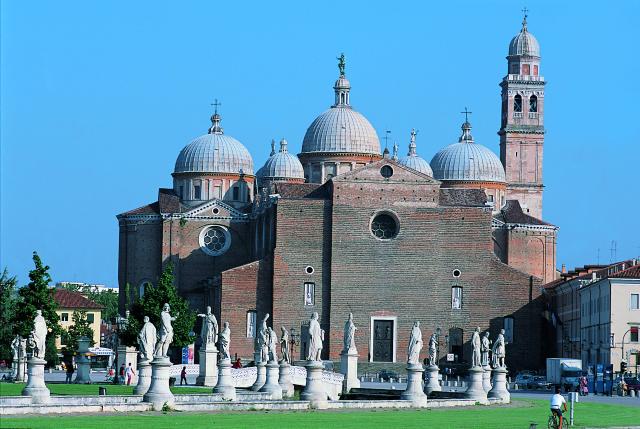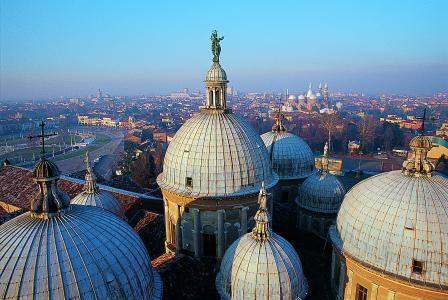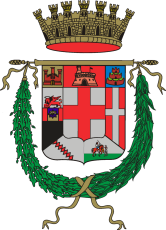
Tipologia museo

Descrizione
L'enorme Basilica di Santa Giustina domina il sud del Prato della Valle. L'imponente chiesa di mattoni risale, nella sua forma attuale, al XVII secolo ed è dedicata alla patrona di Padova, Santa Giustina. Giustina fu giustiziata nel IV secolo a Padova a soli 16 anni; la sua tomba si trova insieme a quelle di altri martiri e dell'evangelista Luca nella Basilica di Santa Giustina. Come la maggior parte delle grandi chiese a Padova, anch'essa possiede una facciata esterna incompleta, il che, però, da un punto di vista ottico non rende meno affascinante questa gigantesca costruzione con le sue otto cupole. La volta del soffitto della chiesa a tre navate è sostenuta da 26 massicce colonne; nelle navate laterali così come nel transetto ci sono complessivamente 20 cappelle riccamente decorate. La pala del grande altare principale fu realizzata da Paolo Veronese e raffigura il "Martirio di Santa Giustina". All'inizio del transetto sinistro si trova il sarcofago di San Luca, secondo la tradizione della Chiesa, l'autore degli Atti degli apostoli e del Vangelo di Luca. A destra dall'altare maggiore si raggiunge il corridoio delle fiere, attraverso la Cappella di San Massimo, e da lì si può raggiungere, attraverso una piccola porta a destra, la cappella di San Luca. Qui è sepolta Elena Lucrezia Cornaro Piscopia, la prima donna al mondo con un dottorato. Il successivo coro vecchio, che confina con il grande corridoio, può essere visitato esclusivamente su richiesta. Attraverso la Cappella di San Matteo nella navata destra, si raggiunge il Corridoio dei Martiri che porta alla cappella funebre di San Prosdocimo. La prima cosa che vedrete è una piccola stanza affrescata, il cui pozzo custodisce le ossa di martiri paleocristiani. Percorrete il corridoio e un po' più avanti, dove si trova l'angolo, troverete una gabbia di ferro con i resti della bara di legno di San Luca: 'La Vecchia Cassa'. Percorrendo il corridoio un altro po', arriverete infine alla cappella funebre di San Prosdocimo, che rappresenta anche la più antica chiesa di Padova. I dipinti sulle pareti della cappella risalgono al VI secolo ed il dipinto sopra il sarcofago raffigura il Santo Prosdocimo. Nel piccolo atrio della cappella è situata sul lato sinistro la tomba di Santa Giustina.
 St. Giustina’s Cathedral and Benedictine monastery
St. Giustina’s Cathedral and Benedictine monastery
The enormous cathedral of St. Giustina dominates the southern area of Prato Della Valle. In its current form, this majestic brick church dates back to the XVII century and is dedicated to the Patron of Padua, St. Giustina. Giustina was executed in the IV century in Padua when she was 16. Her tomb is located in the cathedral of St. Giustina, along with those of other martyrs and the evangelist Luca. As the majority of the largest churches in Padua, its external facade is incomplete. However, the church is not any less fascinating. Twenty-six massive columns support the ceiling vault of this church with three naves. In the aisles, as well as in the transept, there are a total of 20 chapels richly decorated. Paolo Veronese realized the altarpiece of the high altar that depicts the “Martyrdom of St. Giustina”. In the left transept stands the sarcophagus of St. Luca, who, according to the Church tradition, was the author of the Acts of the Apostles and the Gospel of Luca. On the right of the high altar and through the Chapel of St. Massimo, visitors may find the Corridor of the Fairs; from there, they can reach, through a small door on the right, the Chapel of St. Luca. Elena Lucrezia Cornaro, the first woman to obtain a Ph.D., is buried here too. The Ancient Choir, which borders the grand corridor, may be visited only upon request. Through St. Matteo’s Chapel, on the right nave, visitors may reach the Corridor of the Martyrs, which leads to the memorial chapel of St. Prosdocimo. The first thing that comes to the eye is a small, frescoed room whose well shields the bones of some Paleochristian martyrs. Walking down the corridor, visitors will find, near the corner, an iron cage containing the relics of the wooden coffin of St. Luca: it is called “The Old Coffin”. Walking a little further down the corridor, visitors will finally arrive at the memorial chapel of St. Prosdocimo, the oldest church in Padua. The paintings on the walls of the chapel date back to the VI century, and the portrait above the sarcophagus depicts St. Prosdocimo. In the small atrium of the chapel, on the left side, there is St. Giustina’s tomb.

